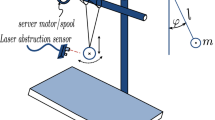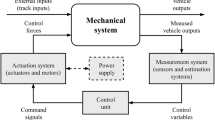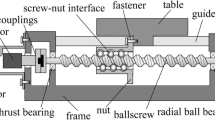Abstract
A vibration quarter-carbody model of a roller coaster running on a spatial trajectory is derived based upon the motion parameters, vertical acceleration, angular velocity, angular attitude, and transient position. These motion parameters are acquired from an ADAMS virtual prototype. The vibration response of the carbody is obtained by solving the differential equations with variable coefficients. Besides, the validity of both the ADAMS virtual prototype and the vibration model is verified by the simulated results versus the actually measured ones. Furthermore, a method, called as space frequency characteristics, is proposed to investigate the relation between the carbody vibration and the motion parameter of roller coaster, which reveals that the carbody vibration is related to its transient position and the influence of the randomness of the motion parameters on the vibration is eliminated. This research is supposed to be helpful for the fault diagnosis of roller coaster by considering both the vibration and motion signals.
























Similar content being viewed by others
References
Pelletier, A.R., Gilchrist, J.: Roller coaster related fatalities, United States, 1994–2004. Inj Prev. 11(5), 309–312 (2005). doi:10.1136/ip.2005.008425
Braksiek, R.J., Roberts, D.J.: Amusement park injuries and deaths. Ann. Emerg. Med. 39(1), 69–72 (2002). doi:10.1067/mem.2002.120127
Fujita, K., Katsuoka, K., Toshimitsu, H.: Dynamics of two-wheels modeling roller coaster running on a complicated 3 dimensional (3D) trajectory considering air resistance. J. Syst. Des. Dyn. 5(3), 403–415 (2011). doi:10.1299/jsdd.5.403
Fujita, K., Toshimitsu, H.: Motion and vbration of a roller coaster consisting of multi-vehicles modelled by two wheels on 3D trajectory. Trans. Jpn. Soc. Mech. Eng. Ser. C 79, 4286–4297 (2013). doi:10.1299/kikaic.79.4286
Fujita, K., Nakagawa, C., Toshimitsu, H.: Motion and vibration analysis for multi-vehicles of a roller coaster on the 3D trajectory. Trans. Jpn. Soc. Mech. Eng. Ser. C 77, 4543–4554 (2011). doi:10.1299/kikaic.77.4543
Liang, C.H., Shen, Y., Qin, P.Y., et al.: Dynamic modeling and simulating for amusement device as roller coasters. China Saf. Sci. J. 17(9), 14–20 (2007). doi:10.3969/j.issn.1003-3033.2007.09.003
Xu, G.I., Xin, J.H., Lu, Y.F., et al.: Kinematics and dynamics simulation research for roller coaster multi-body system. Adv. Mater. Res. 421, 276–280 (2011). doi:10.4028/www.scientific.net/AMR.421.276
Li, G., Zhu, Y.T.: Fault diagnosis system for roller coaster based on acceleration signals. Appl. Mech. Mater. 220–223, 1633–1637 (2012). doi:10.4028/www.scientific.net/AMM.220-223.1633
Wang, H.J., Wang, H.F.: The dynamic simulation model of suspended roller coaster based on virtual prototype. 2010 International Conference on Educational and Information Technology, 193–196. doi:10.1109/ICEIT.2010.5607756 (2010)
Teng, R.M., Wei, G., Gao, S.D., et al.: Dynamic modeling and simulation of roller coaster. 2010 International Conference on Computer Application and System Modeling, 340–342. doi:10.1109/ICCASM.2010.5620012 (2010)
Pombo, J., Ambrosio, J.: Modelling tracks for roller coaster dynamics. Int. J. Veh. Des. 45(4), 470–500 (2007). doi:10.1504/IJVD.2007.014916
Davis, J.I., Birdsong, C., Cota, H.: Vibroacoustic study of circular cylindrical tubes in roller coaster rails. Noise Control Eng. J. 59(4), 333–340 (2011). doi:10.3397/1.3581429
Liu, Z., Wang, L., Xie, B., et al.: Transient position recognition of roller coaster based on the detected motion signal characteristics. Information Science and Control Engineering (ICISCE) 2015 2nd International Conference on. IEEE, 1011–1015. doi:10.1109/ICISCE.20115.228 (2015)
Hyosung, A.H.N., CHEN Y.Q., MOORE, K.L., et al.: Stability analysis and control of repetitive trajectory systems in the state-domain: roller coaster application. 22nd IEEE International Symposium on Intelligent Control Part of IEEE Multi-conference on Systems and Control, 220–225. doi:10.1109/ISIC.2007.4450888 (2007)
Schramm, D., Hiller, M., Bardini, R.: Vehicle Dynamics Modeling and Simulation. Springer, New York (2014)
Gross, D., Hauger, W., Schröder, J., Wall, W.A., Govindjee, S.: Engineering Mechanics 3. Springer, New York (2014)
Haigermoser, A., Luber, B., Rauh, J., et al.: Road and track irregularities: measurement, assessment and simulation. Veh. Syst. Dyn. Int. J. Veh. Mech. Mobil. 53(7), 1–80 (2015). doi:10.1080/00423114.2015.1037312
Luo J.B.: Dynamics simulation for amusement device as roller coaster. Dissertation, South China University of Technology (2012)
Liang, B., Iwnicki, S.D., Zhao, Y., et al.: Railway wheel-flat and rail surface defect modelling and analysis by time-frequency techniques. Veh. Syst. Dyn. 51(9), 1403–1421 (2013). doi:10.1080/00423114.2013.804192
Acknowledgements
This research has been funded by 863 National High Technology Research and Development Program of China under Grant No. 2014AA041502.
Author information
Authors and Affiliations
Corresponding author
Ethics declarations
Conflicts of interest
The authors declare that they have no conflict of interest.
Rights and permissions
About this article
Cite this article
Zheng, L.H., Liu, Z., Chen, M.L. et al. Vibration modeling and position-dependent analysis of spatial trajectory roller coaster. Arch Appl Mech 87, 489–502 (2017). https://doi.org/10.1007/s00419-016-1206-9
Received:
Accepted:
Published:
Issue Date:
DOI: https://doi.org/10.1007/s00419-016-1206-9




